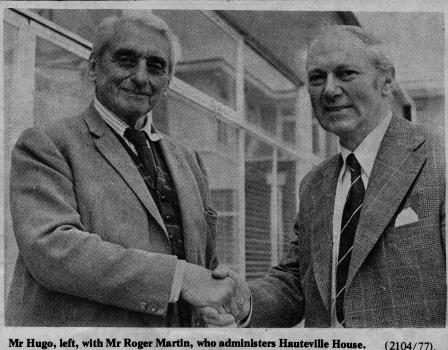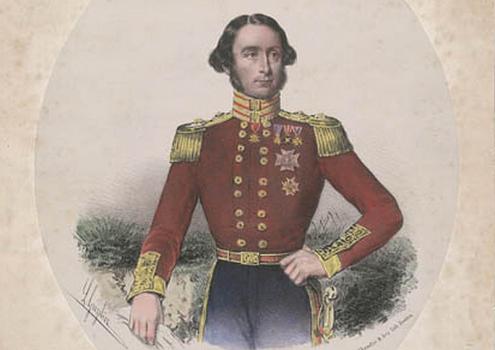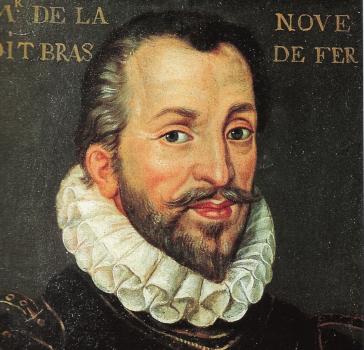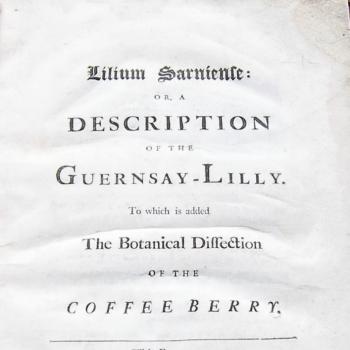3rd April 2019
Jean Hugo was the great-grandson of Victor Hugo. A talented artist and theatre designer, he was a schoolboy at Elizabeth College in Guernsey and made later visits to the island, of which he was very fond, including attending the inauguration of Jean Boucher's celebrated statue of the poet in 1914. The Library has a signed copy of his autobiography, Le Regard de la mémoire, which he gave to Roger Martin, the curator of Hauteville House at the time of his visit in 1977; Roger Martin's ancestor was, coincidentally, one of Victor Hugo's 'poor children.' The photograph is courtesy of the Guernsey Press.By Dinah Bott.
30th November 2015
Some of the Library's books have gone missing over the years. Any book that bears the Priaulx Library stamp or label and that does not have a withdrawal stamp should be regarded as having been removed without permission from the Library collection. These books were given to the people of Guernsey; most are valuable, and some extremely so. We would be most grateful to receive any such missing books back into the fold. Even in the Library's early days, it was expressly forbidden in the Library rules to take any of the rare book collection out of the building. A catalogue of the books in the Library collection immediately after its foundation by Osmond de Beauvoir Priaulx was drawn up by the local historian Reverend George Lee, and published in 1895 by Frederick Clarke of Guernsey, as Catalogue of the Candie Library. Two consecutive annotated volumes of this, with additions to the collection noted by Librarians Percy Groves and Ralph Durand, help to identify more books up to WWII.
21st May 2015
Storms and drought, famine and barrenness, illness and illegality: an Extraordinary Meeting of Guernsey's Colloque, held 24 May 1611, in the presence of the Lieutenant, the ministers, and an elder representing each parish, to arrange a special day of fasting, prayer and humiliation. Such fasting days were, in fact, a quite common occurrence, and continued to be organized by the Church in conjunction with the secular authorities in times of trouble until relatively recently.
18th May 2015
The Friends of the Priaulx Library generously contributed the money needed to buy this Order Book at a local auction. The Anglo-Spanish Legion was a voluntary force of the British Army, raised specifically to aid the Spanish during the Carlist Civil Wars of the 1830s. The Library is very grateful to all those who contributed towards the Friends' donation of this important material.
22nd April 2015
This story is by J R Le Ruez, and was published in the magazine Guernsey Gossip and Visitors' List, June 6 1908. The tale comes from Jersey, and is interesting because of the superstitions and beliefs it is based on; in the seventeenth century Elie Brévint of Sark, himself of Jersey extraction, wrote of the belief that one could aller à la graine de fougère, or 'use the fern seed' and become invisible.
1st April 2015
A list of photographs in the magazine Guernsey Gossip and Visitors' List, which ran weekly during 1907/8; it was based at 42, the Pollet, and was printed by Frederick Watts of the Manor Printing Works. Please contact the Library for further information. The staff photographer seems to have been A Laurens, of 19 the Pollet, and of Jersey, where the magazine (known there as Jersey Week by Week) had its main offices. The 'Weekly Portrait' of an island worthy was accompanied by a biography.
Thomas Phillips illustrated the famous Legge Report, a survey of the Channel islands completed in 1680. His return to the island he had so carefully studied was to prove fatal to him.
From the Parish Registers of St Peter Port.
A well-known tale of intrigue in Renaissance Brittany, in one of its earliest and near-contemporary versions, from The Monthly Illustrated Journal (Guernsey Magazine), February, 1873. The Editor describes this as 'a free translation of an interesting account of a disputed identification case, which occurred in the latter part of the 16th century, and in which Guernsey figures; it is taken from a work entitled La Vie de François, Seigneur de la Nouë, kindly lent to us by Mr Thomas Lenfestey, des Fontaines, for the purpose.' The illustration below is a detail from Sydney's Arcadia, published by Ponsonby in 1589, in the Library collection; the portrait above is of François de la Nouë, dit Bras-de-fer, from the Bibliothèque Nationale de France.
Lilium Sarniense, or, a Description of the Guernsay-Lilly. To which is added The Botanical Dissection of the Coffee Berry. With Figures. By Dr. James Douglas, Honorary Fellow of the Royal College of Physicians, London; and Fellow of the Royal Society. London: Printed by G. STRAHAN, at the Golden Ball, over-against the Royal Exchange, Cornhill. 1725.




